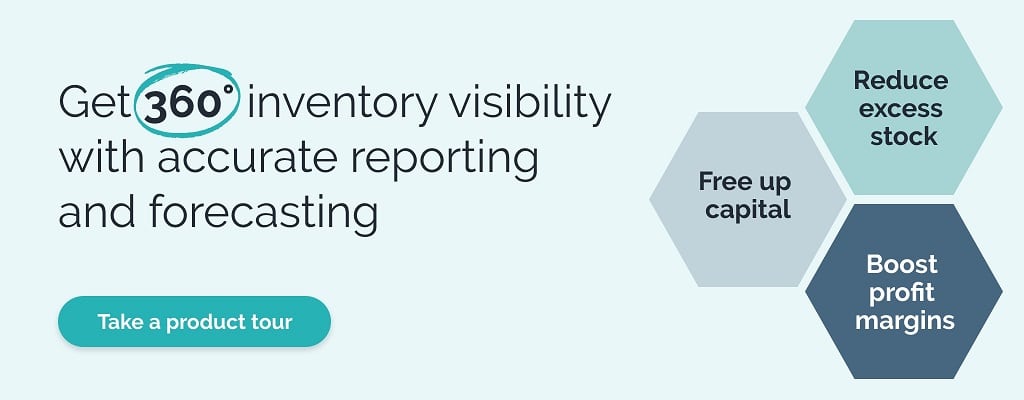
The bare minimum of keeping customers happy in eCommerce is to meet their expectations. That means having the right product in stock, shipped on time, and delivered with no issues.
Needless to say, stock-outs are one of the easiest ways to lose sales (as well as frustrate customers and hurt your brand’s reputation).
One of the best ways to ensure you never run out of a product is to get control of your minimum stock levels.
But how do you find your minimum level? Enter the minimum stock level formula.
This figure will tell you how much stock you should always have to meet customer demand.
A few different methods can be used to calculate minimum inventory levels, all of which we’ll review in this post.
The three primary methods are:
- Average Demand method
- Safety Stock Method
- Reorder Point method
We’ll review how they work, specific formulas, and hypothetical examples of each in an eCommerce context. Let’s dive in.
What are minimum inventory levels?
Your minimum inventory levels (or minimum stock level) are the lowest amount of a product you can have in stock and still meet customer demand.
This number is important because it helps you avoid running out of a product, which could lead to lost sales and unhappy customers.
Why do you need to know your minimum inventory level?

There are a few reasons why it’s important to be aware of your minimum inventory levels. First, as we mentioned, it helps you avoid running out of stock. Second, it can help you save money on storage costs.
If you have too much stock on hand, you may have to pay for storage space that you don’t need.
By keeping your minimum inventory levels in mind, you can avoid the costs of overstocking. Finally, knowing your minimum inventory levels can help you make better decisions about how much stock to order.
If you order too little, you may run into the issue of not being able to meet customer demand. However, if you order too much, you may end up with excess stock that you have to store.
How to calculate minimum inventory levels
Now that we’ve discussed why it’s important to know your minimum inventory levels let’s talk about how to actually calculate them.
There are a few different methods you can use, but we’ll start by focusing on the most common one: the Average Demand method.
To calculate your minimum inventory level, you need to know two things:
- The average amount of time it takes to sell a product
- The average daily demand for a product
Once you have this information, you can use the following formula:
Minimum Inventory Level = Average Daily Demand x Average Time to Sell
Let’s look at an example to see how this works.
Suppose that you own a small business that sells coffee mugs. You know that on average, it takes you two days to sell a mug, and your average daily demand is five mugs.
Using the formula above, we can calculate your minimum inventory level like this:
- Minimum Inventory Level = Average Daily Demand x Average Time to Sell
- Minimum Inventory Level = five mugs x two days
- Minimum Inventory Level = ten mugs
This means that you should always have at least ten coffee mugs in stock.
Another example
Let’s look at one more example to see how this formula works.
Suppose you own a clothing store and you’re trying to calculate your minimum inventory level for t-shirts. You know that on average, it takes you three days to sell a t-shirt, and your average daily demand is ten t-shirts.
Using the formula above, we can calculate your minimum inventory level like this:
- Minimum Inventory Level = Average Daily Demand x Average Time to Sell
- Minimum Inventory Level = ten t-shirts x three days
- Minimum Inventory Level = thirty t-shirts
This means that you should always have at least thirty t-shirts in stock.
Calculating your minimum inventory levels is a critical part of running a successful business. By using the formula above, you can ensure that you always have enough products in stock to meet customer demand.
Using the safety stock method
Another method for calculating minimum inventory is the safety stock method. With this method, you add a certain amount of extra product to your minimum inventory level in order to account for things like supplier delays or unexpected spikes in demand.
To calculate your minimum inventory level using the safety stock method, you need to know four things:
- Your average daily demand – the average number of products that are sold each day.
- Standard deviation demand – a measure of how much your demand varies from day to day. It tells you how much you can expect your demand to fluctuate. If your standard deviation is high, that means that your demand varies a lot from day to day. If your standard deviation is low, that means that your demand is less volatile.
- The average lead time – the average amount of time it takes for you to receive a new shipment of products from your supplier.
- The desired level of safety – how much extra stock you want to have to account for variability in demand. This could be a percentage (e.g., 20%), or it could be a fixed number of units (e.g., 100).
Once you have this information, you can use the following formula:
Minimum Inventory Level = Average Daily Demand x (Standard Deviation of Demand) x (Average Lead Time) x (Desired Level of Safety)
Safety stock formula example
Let’s say that you’re trying to calculate the minimum inventory level for your coffee mug business.
You know that your average daily demand is five mugs, the standard deviation of your demand is two mugs, the average lead time is one day, and the desired level of safety is two.
Using the formula above, we can calculate your minimum inventory level like this:
Minimum Inventory Level = Average Daily Demand x (Standard Deviation of Demand) x (Average Lead Time) x (Desired Level of Safety)
Minimum Inventory Level = five mugs x two mugs x one day x two
Minimum Inventory Level = forty mugs
This means that you should always have at least forty coffee mugs in stock.
As you can see, calculating your minimum inventory levels is a critical part of running a successful online business. By using the formula above, you can ensure that you always have enough products in stock to meet customer demand.
Reorder Point Method
The last method that can be used to calculate minimum inventory levels is the reorder point method.
To use this method, you must first determine how many units of a product are demanded each day, week, or month.
Once you have this number, you will multiply it by the number of days, weeks, or months it takes to receive a new product shipment.
The formula looks like this:
Reorder Point = Average Demand per Day x Number of Days it Takes to Receive New Shipment
For example, let’s say that your business sells widgets, and you receive a new shipment of widgets every week.
If you determine that your business sells an average of 100 widgets daily, you would multiply 100 by seven (the number of days in a week) to get your minimum inventory level of 700 widgets.
More essential inventory control terms to know

Minimum Stock Level Management
This refers to the process of identifying and maintaining the smallest quantity of a particular item that a store should keep in its inventory.
The minimum stock level ensures that operations continue smoothly even if there are unexpected fluctuations in demand or supply. For example, if a retail store determines that its minimum stock level for a specific shoe model is 20 pairs, they should reorder the item when the inventory reaches this number.
Normal Delivery Time
This is the average time it takes for a supplier to deliver goods once an order has been placed.
For example, if a supplier consistently delivers orders within 10 days of placement, that is the normal delivery time.
Minimum Lead Time
The shortest time a supplier can deliver goods after an order has been placed is the minimum lead time.
For example, if a supplier can rush an order and deliver in 5 days when necessary, that’s the minimum lead time.
Normal Consumption
This is the average quantity of an item a store sells within a specific period under regular business conditions.
For example, if a bookstore sells around 50 copies of a particular novel every month, that’s the normal consumption.
Maximum Stock Level
This is the largest quantity of an item that a store should keep in inventory.
Exceeding the maximum stock level could lead to overstocking issues like increased inventory holding costs and risk of obsolescence.
For example, if a clothing store decides not to keep more than 200 shirts of a specific design in stock, that’s the maximum stock level.

Maximum Consumption
This is the highest quantity of an item a store has sold within a specific period, often during peak demand times.
For instance, if a toy store sells up to 100 units of a popular toy during the holiday season, that’s the maximum consumption.
Minimum Quantity
The smallest amount a store can order from a supplier.
For example, a supplier may require orders for a certain product to be no less than 50 units, which is the minimum quantity.
Average Stock Level
This is the mean amount of inventory a store has over a given period.
It can be calculated by adding the maximum and minimum stock levels and dividing by two.
If a store has a maximum stock level of 200 items and a minimum of 50, the average stock level is 125 items.
Minimum Demand
This is the lowest quantity of an item that customers have purchased within a specific period, often during off-peak times.
For example, if a swimwear retailer sells only 10 swimsuits during winter, that’s the minimum demand.
Understanding these terms is crucial for effective inventory control and management.
They help retailers decide when and how much to reorder, ensuring they can meet customer demand while avoiding overstocking or stockouts.

Final Thoughts
Setting minimum stock levels is essential to keeping customers happy and maintaining positive cash flow.
Three main methods can be used to calculate minimum inventory levels: Average Demand method, Safety Stock method, Reorder Point method
Each of these methods has its advantages and disadvantages, so it’s important to choose the one best suited for your business.
Using the information in this blog post ensures you always have enough products in stock to meet customer demand.
If you’re overwhelmed by the idea of tracking all these metrics manually, it’s high time to invest in an inventory management solution like SkuVault.
SkuVault exists to automate the tedium of managing your inventory, including giving you automated reorder point alerts based on inventory thresholds.
And this scratches the surface of how SkuVault can help you save hours of time and loads of headaches in running your eCommerce business.
For a more detailed breakdown of how SkuVault can level up the logistics in your organizations, check out this detailed, 2-minute walkthrough of the platform.


